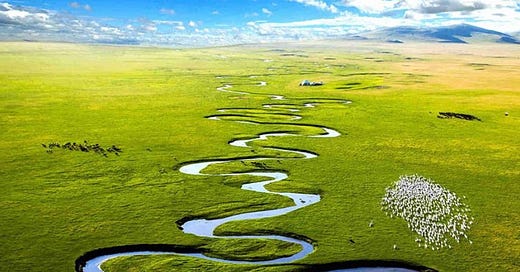Chinese Peripheries
China has always been molded by its land boundaries. Throughout recorded history, this is where the Han people of China encountered, fought, conquered, were conquered, and co-existed with numerous cultures and civilizations. China’s peripheries are fault lines. Borderlands that have been absorbed, resisted, erased, and reasserted over time. This was as true when a smaller, historic China was centered in the heartland between the Yellow and Yangtze Rivers as it is with the larger, internationally recognized China of today.
Xilingol Grassland, Inner Mongolia, China (www.chinadiscovery.com)
The Question
China has one of the world’s most formidable peripheries. It shares borders with fourteen countries, and where China meets its neighbors lies some of the earth’s most challenging terrain—rivers, grasslands, deserts, mountains, plateaus, and vast uninhabited spaces. These boundaries are not just geographic. They are strategic, cultural, and deeply historical.
Nine parts of China touch these borders, including five provinces (Liaoning, Jilin, Heilongjiang, Gansu, and Yunnan) and four autonomous regions (Inner Mongolia, Xinjiang, Tibet, and Guangxi). Among them, Xinjiang and Tibet are the most well-known in the West. They stir intense emotions—accusations of occupation, repression, civil rights abuses, even genocide. These names trigger economic sanctions, political backlash, and outrage. They are raw.
But no matter how we characterize life on the ground in these faraway places, whether we agree or disagree with Chinese policy and actions, whether we feel they are moral, immoral, or none of our business, there is one, fundamental question that often goes unasked:
Why?
Why does the Chinese government set policies and operate as it does in these regions?
Why is key.
Taklamakan Desert, Xinjiang, China (www.journeybeyondhorizon.com)
A Brief History
North and west of China as it has existed from time to time were forever seen as wild and uncivilized, home to peoples outside the Han Chinese world. But these places outside of Han China were not to be trifled with.
Two of those so-called barbarian lands—the Mongolian steppe and Manchuria from the north and northeast—repeatedly proved stronger, conquering parts or all of China and ruling it under their own dynasties. The Mongols founded the Yuan Dynasty in the late 13th century. The Manchu people ruled three times: during the Liao, Jin, and Qing Dynasties. The Qing, the last imperial dynasty, governed China from the mid-1600s until the early 20th century.
Much of the Manchu and Mongolian homelands and conquests remain part of China today. The other border regions were incorporated into China gradually, though mostly also long ago. Gansu before the 10th century. Yunnan in the 13th. Xinjiang in the 18th. Guangxi has moved in and out of Chinese control since the first century BCE. Tibet controlled much of the western plateau up into what is now Xinjiang and Gansu 1,200 years ago, and maintained quasi-independence under the Qing before falling under full Chinese control in the mid-20th century.
These territories were inhabited by non-Han peoples, and they remain home to most of China’s minority populations. Over the millennia, their relationship with Han China has been rocky. Some were powerful, independent civilizations in their own right. All were eventually forcibly integrated. Some still feel conquered. Border clashes and territorial intrigues continue to this day at the extremities of these Chinese peripheral zones (for example, in India and Bhutan).
Note: China’s maritime hotspots—principally, Hong Kong, Taiwan, the Senkaku Islands, and the South China Sea, are worthy topics for another day.
Kunlun Mountains, Tibet, China (www.peakvisor.com)
A Response
Why are these land frontiers so controversial in Chinese history, and why is it important for us in the West to look at them from a different perspective?
Former U.S. President Barack Obama once commented that “the study of geography is about more than just memorizing places on a map. It’s about understanding the complexity of our world, appreciating the diversity of cultures that exists across continents. And in the end, it’s about using all that knowledge to help bridge divides and bring people together.”
Such complexity and diversity do not exist just between countries. They also exist within them. And China’s peripheries are a perfect example of that internal friction.
Picture the following scenario:
A nation’s government and elites fear that the country's stability, unity, and progress—and by extension, their own power—are under threat. Economic inequality is rising. Hope is fading. Entire regions bristle against central control. Dissent spreads. Protests erupt. The state clamps down. Freedoms are restricted. Surveillance expands. Institutions of knowledge and communication are controlled, revised, sanitized. Cultural harmony—efforts to promote proper thinking and acting, is enforced from the top down. Dissent is labeled extremism. The military is deployed.
This is both the alarm and the motivation that drive China’s leadership. And this is how they presumably support their policies and orders behind closed political doors. It is not a uniquely Chinese story. It is recognizable and relatable. Versions of the same script exist in many nations, including our own. Fear of outsiders, fear of nonconformity, a desire for control, a belief in the necessity of domination as the safeguard against chaos—these are not alien concepts. They are deeply human ones.
From the outside, the West sees oppression, repression, and suppression in China’s peripheries and erupts with indignation. But from the Chinese leadership’s perspective, these regions are powder kegs. They see them as potential existential threats to national unity, vital for access to natural and strategic resources, and challenges to their own power. The means, however severe, are justified by the perceived end: preserving order, maintaining culture, defending sovereignty.
We can debate the merits of Chinese actions in its borderlands. We can question propaganda, condemn perceived abuse, and critique the consolidation of power. But we should also take the time to understand the Why. Acknowledgement of the Why does not mean acceptance. It is explanation. It can be a step forward. There is no one, simple response.







Concise history lesson, Andrew. Well done.